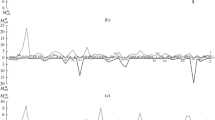Abstract
Atmospheric aerosols have been measured in Finnish Lapland from January 1992 to June 1994. A seasonal cycle in particle number concentration, measured using a condensation particle counter, is observed. Aerosol samples have been collected by a virtual impactor (VI) in two size ranges. The filters have been changed every 48 hours. Most fine particle samples are acidic: 91% of the measured anions (neq/m3) to measured cations (neq/m3) ratios are above one. According to a trajectory statistical analysis, high sulphate concentrations come to Finnish Lapland from all of continental Europe. The source areas of the highest observed ammonium concentrations are in Western Europe.
Similar content being viewed by others
References
Mäkinen, M., Pakkanen, T., Hillamo, R., Virkkula, A., and Mäkelä, T. (1994) Ion balance of aerosol in Northern Finland.Journal of Aerosol Science 25, May 1994, S299–300.
Li, S.-M. and Winchester, J. (1989) Geochemistry of organic and inorganic ions of late winter arctic aerosols.Atmos. Env. 23 11 pp. 2401–2415.
Shaw, G., E. (1991) Physical properties and physical chemistry of Arctic aerosols. In Sturges, W.T. (Editor)Pollution of the Arctic atmosphere. Elsevier Science Publishers LTD, England. pp. 123–154
Sheridan, P.J. (1989) Characterization of size segregated particles.Atm. Env. 23 2371–2386.
Stohl, A. (1995) Trajectory statistics — a new method to establish source-receptor relationships of air pollutants and its application to the transport of paniculate sulfate in Europe. Submitted toAtmos. Env.
Stohl, A., Wotawa, G., Seibert, P., and Kromp-Kolb, H. (1995) Interpolation errors in wind fields as a function of spatial and temporal resolution and their impact on different types of kinematic trajectories.J. Appl. Meteor. In press.
Valkama, I. and Rossi, J. (1992) Description of the model TRADOS. In Klug, W., Graziani, G., Grippa, G., Pierce, D. & Tassone, C.Evaluation of long range atmospheric transport models using environmental radioctivity data from the Chernobyl accident. The ATMES report, Elsevier Publ.
Virkkula, A., Hillamo, R., Mäkinen, M., Mäkelä, T., and Pakkanen, T. (1994) Number concentrations of atmosheric aerosol in the Finnish Arctic.Journal of Aerosol Science 25, May 1994, pp. S25–S26.
Wolfenbarger, J.K. and Seinfeld, J.H. (1990) Inversion of aerosol size distribution data.J.Aerosol Sci. 21, 227–247
Author information
Authors and Affiliations
Rights and permissions
About this article
Cite this article
Virkkula, A., Mäkinen, M., Hillamo, R. et al. Atmospheric aerosol in the finnish arctic: Particle number concentrations, chemical characteristics, and source analysis. Water Air Soil Pollut 85, 1997–2002 (1995). https://doi.org/10.1007/BF01186127
Issue Date:
DOI: https://doi.org/10.1007/BF01186127



